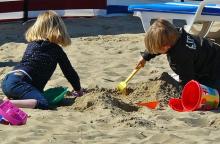
Associative Play is one of the categories used to describe the development of social play by preschoolers. It is generally the first stage where social interaction is required in children’s play as they engage in a mutual activity, though not working toward a common goal.
In 1932, Mildred Parten, at the University of Minnesota’s Institute of Child Development, developed a system for classifying participation in play by children that has been widely accepted. Her six stages were unoccupied play, solitary play, onlooker play, parallel play, associative play, and cooperative play. Her theory was that as children grew older with improved communication skills and more opportunities for interaction with other children, their solitary play would become more social.1
Play helps children learn how to act in social settings. Parten’s categories provide guidelines for understanding how children move from solitary play to more social categories of play as they grow older.2 Children will move through the six stages as they grow and develop, although they might not progress in a linear order. Depending on children’s physical environment and their individual temperament, they may engage in different stages at different times.3
An initial form of playing, unoccupied play is described as the random movements an infant makes as he becomes aware of objects around him. Because toddlers have limited social, cognitive, and physical skills, their self-centered nature encourages them to engage in solitary play exploring their world in independent play. Onlooker play describes when children observe other children playing, but don’t join in with them. By the time children reach three years of age, they may engage in parallel play where they play independently, but side by side seemingly not involved with others. Parallel play is seen as an important bridge to the later stages of play.4
Associative play also describes children playing separately from one another, but they are involved with what the others are doing. This may include a constructive play activity where they are involved with others in building a structure. The children may all be engaged in a similar activity, but there is no division of labor and no organization of the activity around what materials they use or what goal they are attempting to achieve. Each child has his own interests in his play and doesn’t need to conform to what the others are doing.5
Young children develop their communication skills through play. Though still learning how to verbalize how they feel, play offers a safe environment to exhibit their full range of feelings while playing with others. During associative play children may make mild attempts to control which children may or may not play in the group and as a result they begin to understand the dynamics of social play.6
Through associative play, children begin to learn how to make real friendships. They become more interested in other children than in the toys. They develop skills in socialization, problem solving, sharing, cooperation, and language development. This leads to cooperative play where play is organized by group goals. Children move from a self-centered view to an understanding of the importance of social rules to develop friendships. In cooperative play they begin to play games with rules and gain the concept that life has rules that everyone must follow.7
- 1. Tomlin, Carolyn R. “Play: A Historical Review.” EarlychildhoodNEWS. < http://www.earlychildhoodnews.com/earlychildhood/article_view.aspx?ArticleID=618 > 9 June 2016.
- 2. Frost, Joe L., Sue Wortham, and Stuart Reifel. Play and Child Development. Upper Saddle River, NJ: Prentice-Hall, Inc. 2001.
- 3. Cecchini, Marie E. “Encouraging Cooperative Play.” EarlychildhoodNEWS. < http://www.earlychildhoodnews.com/earlychildhood/article_view.aspx?articleid=707 > 11 Oct. 2016.
- 4. Rock, Amanda. “10 Types of Play Important to Your Child’s Development.” Verywell. < https://www.verywell.com/types-of-play-2764587 > 11 Oct. 2016.
- 5. Op. cit., Frost et al.
- 6. “What is Associative Play?” Psychology & Science. < http://www.psysci.co/associative-play/ > 12 Oct. 2016.
- 7. Anderson-McNamee, Jona K. and Sandra J. Bailey. “The Importance of Play in Early Childhood Development.” Montana State University Extension. < store.msuextension.org/publications/HomeHealthandFamily/MT201003HR.pdf > 11 Oct. 2016.

